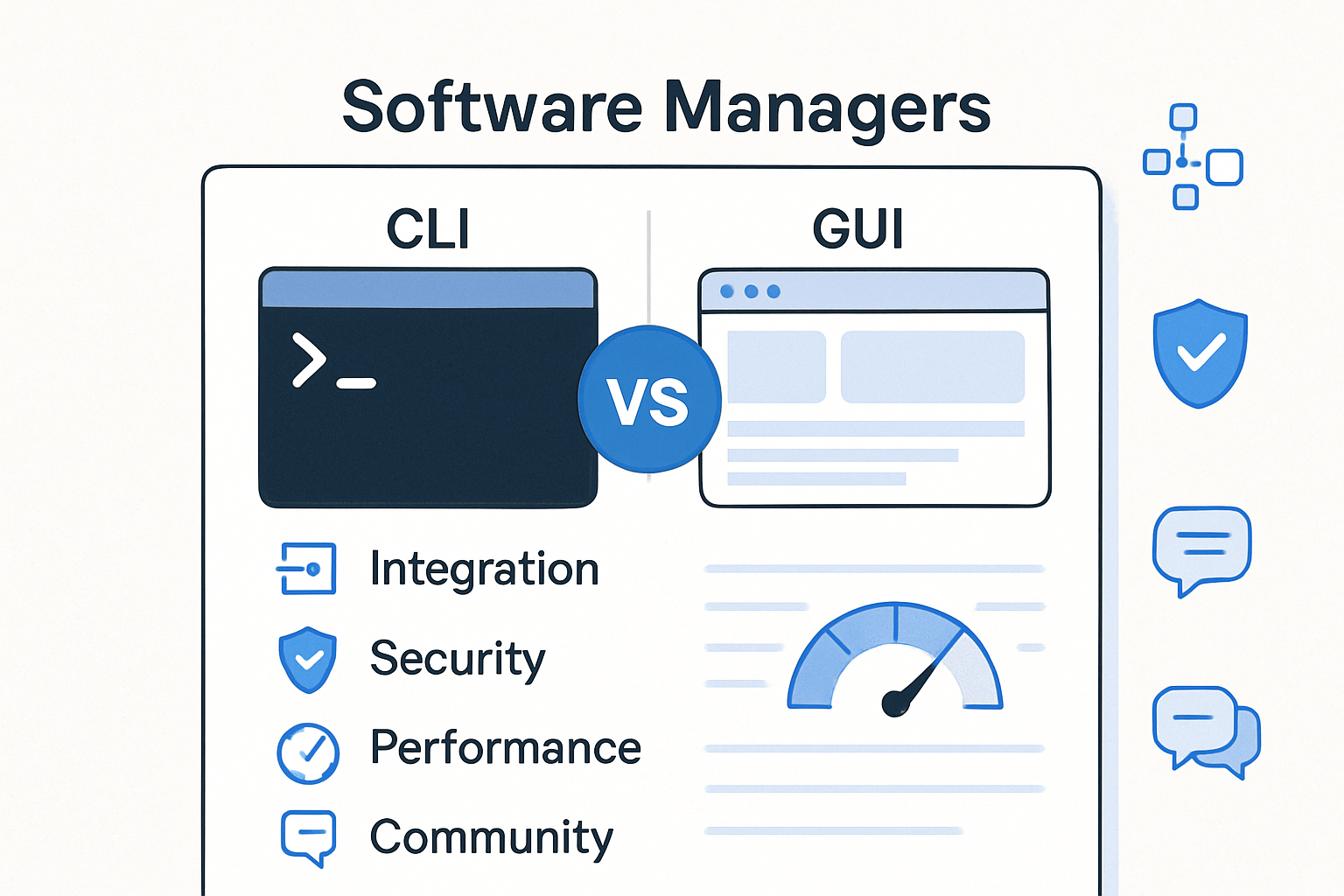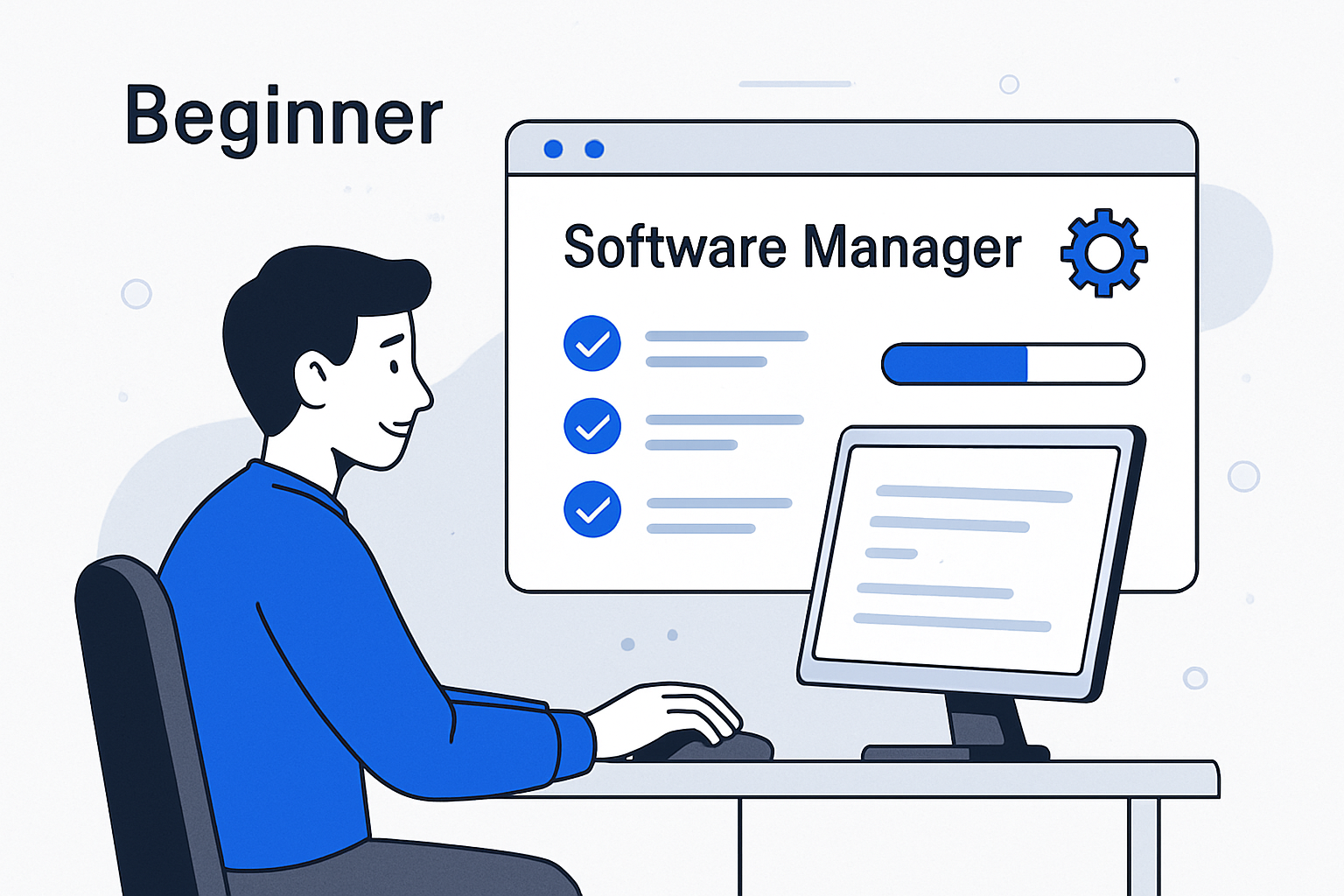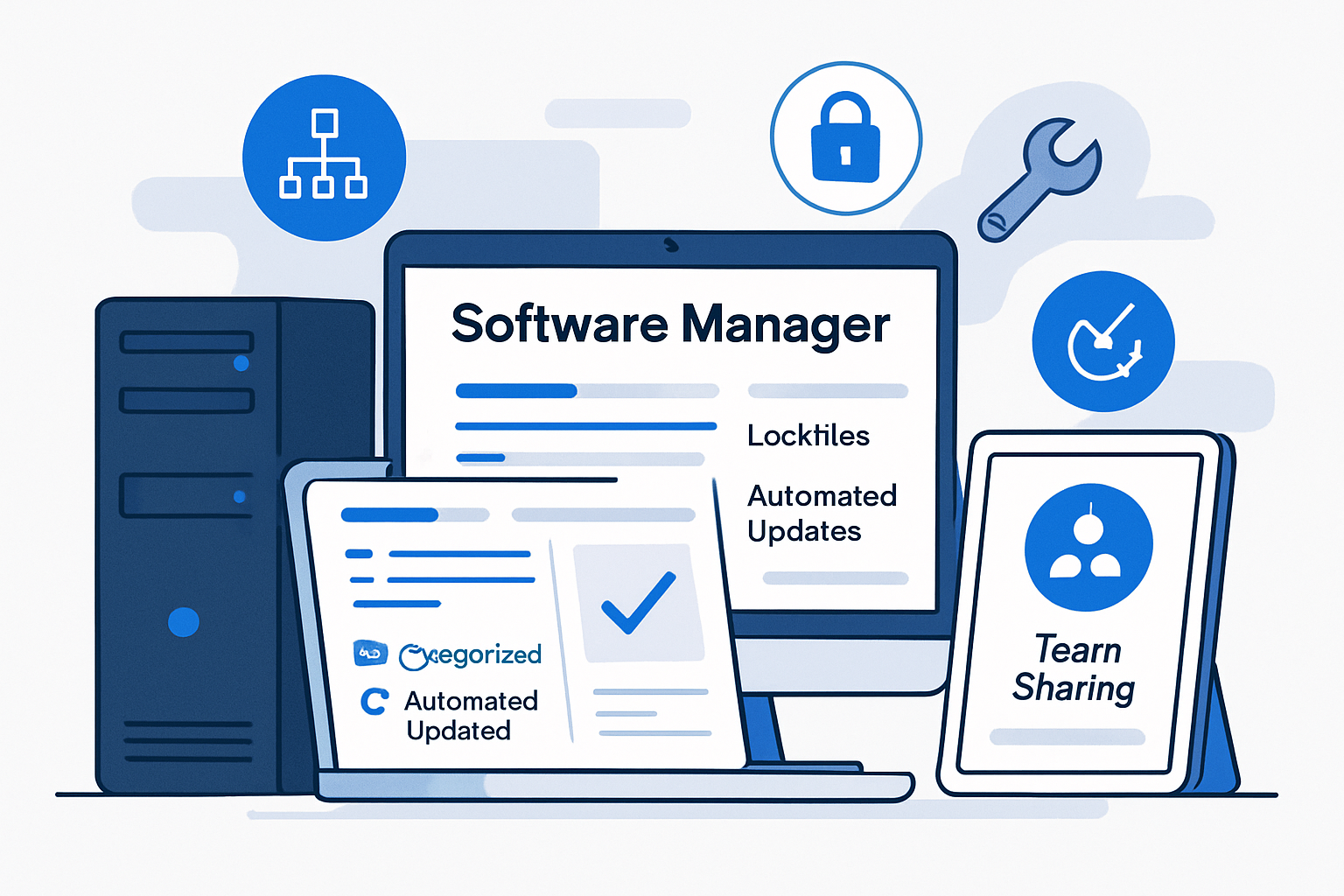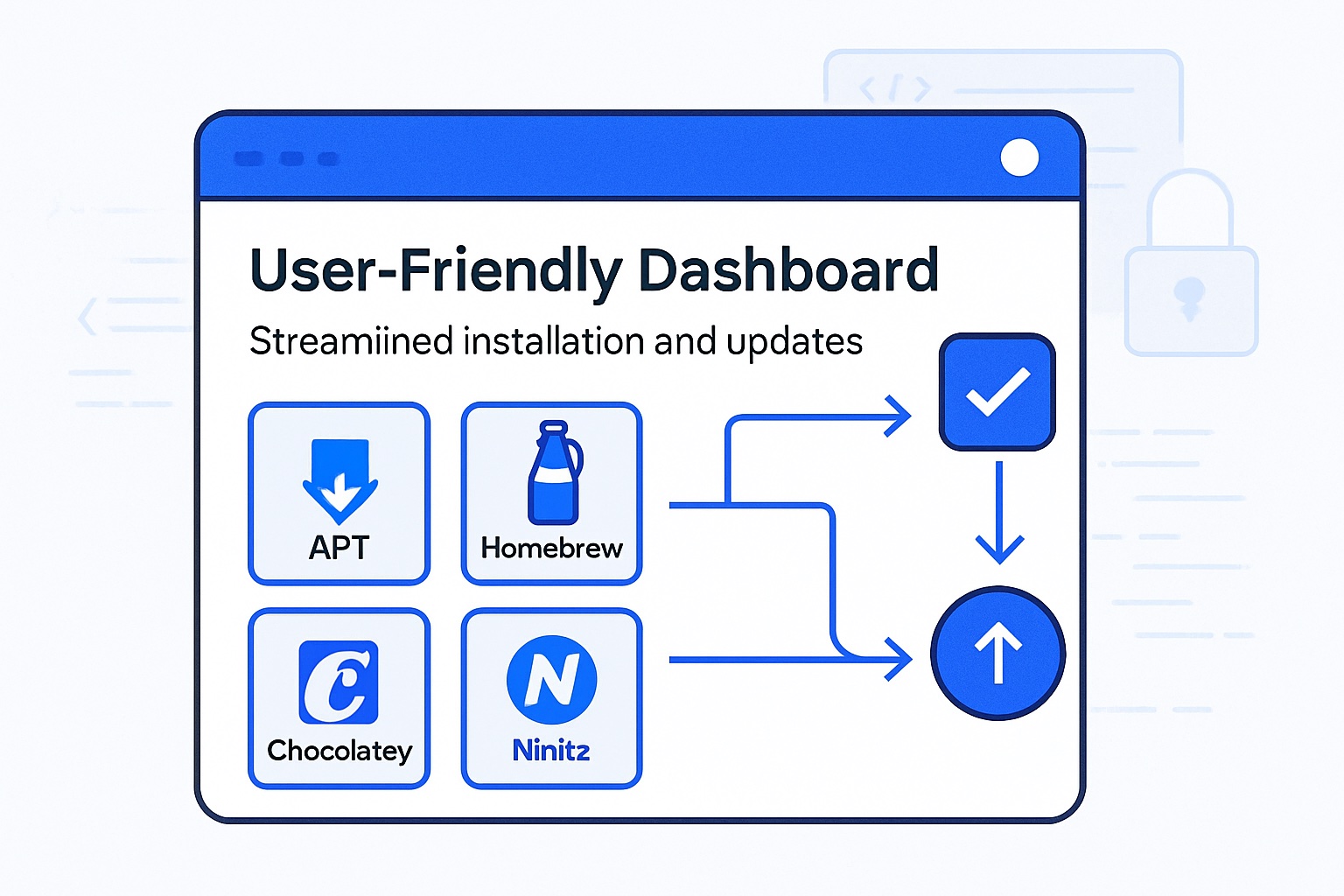Navigating the world of software managers can feel overwhelming for beginners, especially with so many options available in 2025. Yet, choosing the right tools is essential for productivity and peace of mind.
This guide will demystify software managers, breaking down what they are, their features, and how to get started. You’ll discover practical steps and expert insights to confidently manage your software environment.
Ready to simplify your workflow? Dive in to explore essential knowledge, best practices, troubleshooting tips, and a glimpse into the future of software management.
What Are Software Managers?
Understanding software managers is key for anyone starting out in modern computing. At their core, software managers are tools that automate the process of installing, updating, and removing applications or packages on your system. They act as centralized hubs, simplifying what would otherwise be a complex, manual process. These tools can be divided into package managers (like APT or Homebrew), app managers (such as Ninite), and dependency managers (like npm or pip), each designed to handle different types of software and environments.
Definition and Purpose
Software managers are specialized tools designed to streamline the management of applications and dependencies on computers. Their main purpose is to handle the installation, updating, and removal of software with minimal user intervention.
There are distinct categories: package managers focus on system-level software, app managers target user applications, and dependency managers handle libraries for programming projects. This makes software managers essential for keeping systems efficient and organized. By automating repetitive tasks and minimizing errors, they pave the way for smoother workflows.
Why Beginners Need Software Managers
For beginners, software managers are a game changer. They take the guesswork out of managing software, offering guided commands or graphical interfaces that make complex tasks much simpler.
One of their biggest advantages is reducing the risk of running outdated or insecure programs, as they make it easy to keep everything current. Software managers also centralize control, so users don't have to hunt for updates or manage individual applications separately. According to Stack Overflow's 2024 survey, over 70% of developers now rely on package managers—a testament to their widespread adoption and value.
Types of Software Managers
Software managers come in various forms, each catering to different needs and platforms. System-level managers like APT (for Linux) and Homebrew (for macOS) handle core software and dependencies. Application-level managers, such as Ninite, focus on everyday user applications. Some tools are cross-platform, while others are tailored to specific operating systems. For Windows, Windows Package Manager Overview and Chocolatey are popular choices.
There are also open-source options, which encourage community contributions, and proprietary tools, which may offer dedicated support. Real-world usage varies: APT and YUM are staples on Linux, Homebrew dominates macOS, and Windows users often choose Winget or Chocolatey.
Common Features and Capabilities
Most software managers share a core set of features that make them invaluable. Automated installation and updates mean users spend less time on routine maintenance. Dependency resolution ensures all required components are present, avoiding frustrating errors.
Many tools support rollback and version control, so you can easily revert to previous software states if something goes wrong. Security is also a priority, with features like signature verification guarding against tampered or malicious packages. These capabilities together create a safer, more reliable software environment.
How Software Managers Have Evolved
The evolution of software managers has been remarkable. Early days required manual downloads and installations, often leading to compatibility issues. Now, user-friendly interfaces—both command-line and graphical—have made the process accessible to everyone.
Integration with cloud services and container technologies means software managers can handle complex, distributed environments with ease. Recent years have also seen a rise in GUI-based managers, which are especially helpful for beginners. The result is a new era where managing software is not just easier, but also smarter and more secure.
Key Features to Look for in a Software Manager
Choosing the right software managers starts with understanding the core features that make them effective for beginners and pros alike. The right set of features can save you hours, prevent headaches, and keep your system running smoothly.

User Interface and Ease of Use
A user-friendly interface is essential when evaluating software managers. Some offer command-line interfaces (CLI), which provide speed and flexibility but can be intimidating for newcomers. Others come with graphical user interfaces (GUI), making navigation easier for beginners.
Clear documentation and active community support can make a significant difference, especially when you hit a roadblock. Accessibility features, such as keyboard navigation or screen reader support, can help ensure software managers are usable for everyone.
Compatibility and Integration
Compatibility is a cornerstone for software managers. Look for tools that support your operating system—whether it’s Windows, macOS, or Linux. Cross-platform support can be a game-changer if you work across multiple devices.
Integration with DevOps tools and CI/CD pipelines is vital for those automating workflows. Modern software managers often support both legacy and cutting-edge applications, allowing seamless operation regardless of your tech stack.
Security and Reliability
Security should never be an afterthought with software managers. Top options pull from secure repositories and verify package signatures before installation. Automatic vulnerability scanning and patching help protect against threats.
Did you know that 60% of cyberattacks exploit outdated software? That’s why reliable software managers offering regular updates are crucial for reducing risk and keeping your system safe.
Performance and Efficiency
Performance matters, especially when managing large numbers of applications. Efficient software managers use minimal resources and execute tasks quickly. Batch processing and automation features let you update or install multiple programs at once, saving valuable time.
For example, Homebrew’s speed improvements in 2024 have made it possible to manage hundreds of packages with ease. Always consider how software managers handle heavy workloads or complex environments.
Customization and Extensibility
Customization is key for power users. The best software managers support plugins or scripting, letting you fine-tune workflows and add new capabilities. Advanced users can tweak configuration files to control how installations, updates, and rollbacks happen.
Extensibility ensures software managers grow with your needs. Whether you’re adding custom repositories or automating setups, flexibility is a must for long-term satisfaction.
Community and Ecosystem
A thriving community can be a lifeline when you need help or inspiration. Look for software managers with active forums, regular updates, and robust package repositories. Communities often drive innovation, fix bugs, and provide real-world solutions.
For example, Chocolatey’s large repository and frequent contributions make it a favorite among Windows users. Strong ecosystems ensure your chosen software manager stays relevant and well-supported.
Step-by-Step Guide: Setting Up Your First Software Manager
Setting up your first software managers might feel like venturing into uncharted territory, but following a structured approach will make things much simpler. This step-by-step guide is designed to walk you through the process, from choosing the right software managers to mastering everyday tasks and best practices.

Step 1: Assess Your Needs and Choose the Right Manager
Before diving in, it's essential to understand your environment and workflow. Are you using Windows, macOS, or Linux? Each operating system has its preferred software managers, so make sure you match the right tool to your platform.
Here's a quick comparison to help you decide:
ManagerOS SupportInterfacePopular Use CaseHomebrewmacOS, LinuxCLI/GUIDev & general usersChocolateyWindowsCLI/GUIEnterprise, DevAPTLinuxCLISystem managementNiniteWindowsGUIBulk installs
Consider key factors:
When evaluating software managers, think about compatibility with your workflow, the learning curve, and future project requirements. Prioritizing ease of use and support will set you up for success.
Step 2: Installation Process
Once you've picked your software managers, it's time to install. Start by downloading the official installer from the project's website. Always verify the file integrity—many managers provide checksums or digital signatures for security.
Follow these steps for installation:
Here’s a sample Homebrew installation command for macOS:
/bin/bash -c "$(curl -fsSL https://raw.githubusercontent.com/Homebrew/install/HEAD/install.sh)"
If you run into issues, consult documentation or community forums. Beginners often face installation hurdles, as highlighted in this Empirical Study on Package Management Issues. Don’t hesitate to seek help—most problems have straightforward solutions.
Step 3: Initial Configuration
After installation, configure your software managers for smooth operation. Set environment variables and update your system’s PATH to ensure commands work everywhere. Most managers provide setup instructions to guide you through this.
Customize default repositories to access a broader range of software. You can often add or remove sources to suit your preferences. For security, adjust user permissions so that only trusted accounts can modify critical settings.
Configuration tips:
Proper initial configuration of software managers minimizes future headaches and streamlines daily use.
Step 4: Installing and Managing Software
With everything set up, you’re ready to install and manage software. Use search commands to find packages. For example, with Homebrew:
brew search firefox
To install, update, or remove software, use simple commands or the GUI if available:
Pay attention to package metadata, such as version numbers and dependencies. Software managers handle most dependencies automatically, but occasionally you’ll need to resolve conflicts manually. Clear documentation and community forums can help if you get stuck.
Step 5: Automating Tasks and Updates
One of the biggest advantages of software managers is automation. Schedule automatic updates to keep your software secure and current. Many managers allow you to script bulk installations—ideal for setting up new systems or deploying across multiple devices.
For example, Homebrew users can use a Brewfile to automate setups:
brew bundle --file=~/Brewfile
Automation tips:
Automating with software managers saves time and ensures consistency.
Step 6: Best Practices for Beginners
Maximize your success by following these best practices:
Organize your installed packages with tags or manifests for easy reference. Document any changes you make to settings or scripts. If you encounter issues, consult logs and forums before escalating to official support.
By developing good habits early, you’ll get the most out of software managers and avoid common pitfalls as your needs grow.
Best Practices for Managing Software Efficiently
Staying organized with software managers is crucial for anyone aiming to streamline their workflow and avoid chaos as your tech stack grows. By following a few practical best practices, you’ll save time, boost security, and maintain a healthy digital environment—all while making the most of your software managers.

Organizing and Categorizing Software
One of the first steps to mastering software managers is to keep your installed applications organized. Grouping tools by function or project makes it easier to track updates and troubleshoot issues.
A simple table can help visualize your software organization:
ApplicationCategoryManager UsedLast UpdatedVS CodeDevelopmentHomebrewMay 2025SlackCommunicationChocolateyJune 2025GIMPDesignAPTMay 2025
By leveraging these features, software managers help you maintain structure and ensure nothing slips through the cracks.
Ensuring Security and Compliance
Security is non-negotiable when using software managers. Always verify the source of your packages and check digital signatures before installation.
Software managers often come with built-in tools for signature verification and repository validation. These features help you avoid tampered or malicious packages, supporting a safer software ecosystem.
Monitoring and Maintenance
Regular maintenance keeps your system lean and secure. Software managers make it easy to perform health checks, audit installed packages, and remove unused software.
Unused applications can increase your security risk. Run audits to spot outdated or vulnerable packages. Many software managers use lockfiles to track dependencies and versions. For a deeper dive into lockfile strategies and their impact on package management, see the Design Space of Lockfiles Across Package Managers.
Keeping up with maintenance ensures your system stays efficient and secure.
Collaborative Management in Teams
When working in teams, software managers support collaborative workflows and consistent environments. Sharing package manifests or lists helps everyone stay on the same page.
By leveraging these features, software managers enable seamless collaboration, reduce configuration drift, and help teams scale efficiently.
Troubleshooting and Support
Even with best practices, issues can arise. Software managers offer tools for troubleshooting, such as detailed logs and error messages.
By making use of these support systems, you ensure that software managers remain a reliable part of your workflow, minimizing downtime and frustration.
Troubleshooting Common Issues with Software Managers
Even the best software managers can encounter bumps along the way. Knowing how to troubleshoot common problems keeps your workflow smooth and stress-free.
Installation and Update Failures
Installation or update failures are among the most frequent issues faced with software managers. These problems can stem from several sources:
If you hit a snag, check your internet connection first. Next, review any error messages or logs produced by your software managers. For permissions, try running the installer or update command as an administrator. Clearing the package cache can also resolve stubborn issues.
sudo apt-get clean
brew update --force
A methodical approach helps you quickly pinpoint the cause and get back on track.
Dependency Conflicts and Errors
Dependency conflicts occur when two packages require incompatible versions of the same library. This is a classic challenge with software managers, especially when juggling multiple tools or languages.
Understanding the dependency tree is vital. Most managers provide commands to visualize or list dependencies, such as apt-cache depends or brew deps.
Resolving these conflicts early prevents larger issues down the line.
Security and Trust Concerns
Security is crucial when working with software managers. Malicious packages or compromised repositories can put your entire system at risk.
To minimize exposure:
A helpful resource is the official Homebrew security guide. Staying vigilant ensures you benefit from the convenience of software managers without compromising your system.
Performance and Resource Issues
Sometimes, software managers may slow down or consume excessive system resources. This typically happens during large updates, batch installations, or when background processes pile up.
To troubleshoot:
Regular maintenance, like clearing caches and removing obsolete packages, keeps your software managers running efficiently.
Recovering from Critical Failures
Even with precautions, critical failures can happen—like a broken update or a corrupted manager. Thankfully, most software managers include features to recover gracefully.
Key steps include:
By learning these recovery techniques, you can confidently experiment and update, knowing you have a safety net.
The Future of Software Managers: Trends and Innovations
The landscape of software managers is rapidly evolving, driven by advances in automation, cloud, security, and user experience. Let’s explore the innovations that are shaping how we’ll manage software in 2025 and beyond.
AI and Automation in Software Management
AI is transforming how software managers operate, making updates and dependency handling smarter than ever. Predictive algorithms can now suggest optimal update times, reducing downtime and improving reliability. Automated vulnerability scanning uses machine learning to identify and patch threats before they become critical.
For example, early enterprise tools leverage AI to automate bulk software updates across networks, minimizing human error. Some open-source projects are experimenting with AI-driven package resolution, which could soon become a standard feature. As AI matures, expect software managers to become even more proactive and efficient.
Integration with Cloud and Containers
Modern workflows demand that software managers seamlessly handle both local and cloud environments. Integration with container platforms like Docker and orchestration tools such as Kubernetes is now a must-have. This unified approach lets users manage software stacks consistently, whether on-premises or in the cloud.
Software managers are evolving to support hybrid deployments, enabling teams to automate installations across virtual machines, containers, and cloud-native platforms. This flexibility ensures that development and production environments stay in sync, no matter where they run.
Enhanced Security and Compliance Features
Security is at the forefront of software managers’ evolution. Advanced tools now include automatic scanning for vulnerabilities and supply chain attacks. Features like digital signature verification and secure repositories help guarantee package authenticity.
For organizations, built-in compliance reporting simplifies meeting regulatory requirements. Enterprises can monitor software usage and security status from a central dashboard, reducing manual audits. As security threats grow, software managers are becoming key defenders in the software lifecycle.
User Experience Improvements
User experience is a major focus for next-generation software managers. Intuitive graphical interfaces are lowering the barrier for beginners, while onboarding wizards guide users through setup and management tasks. Some tools now offer voice commands or chatbot support for hands-free operation.
Accessibility is also improving, with better support for screen readers and keyboard navigation. These enhancements make software managers more approachable for everyone, regardless of technical skill level. Expect user-centric design to become a defining feature.
Expanding Ecosystems and Community-Driven Development
The community around software managers is thriving. Open-source contributions drive rapid innovation, and large ecosystems mean more packages, plugins, and integrations. In 2025, new package formats and standards are emerging, offering greater flexibility and compatibility.
Active forums and user groups help solve problems quickly and share best practices. As the ecosystem grows, software managers benefit from faster updates and more robust support. This collaborative spirit ensures that software managers stay relevant and adaptable.
You've just explored the essentials of software managers and how they can simplify your workflow, especially if you're just starting out. If you're feeling inspired to take your next step—maybe building your first project or MVP without getting lost in complicated code—you're not alone! At Big House Technologies, we help founders and teams like you turn ideas into scalable products quickly and efficiently. Curious about what's possible with the right no-code tools? Take a look at what we've built for others just starting out:
See What We’ve Built for Founders Like You




About Big House
Big House is committed to 1) developing robust internal tools for enterprises, and 2) crafting minimum viable products (MVPs) that help startups and entrepreneurs bring their visions to life.
If you'd like to explore how we can build technology for you, get in touch. We'd be excited to discuss what you have in mind.
Other Articles
Build a powerful bubble website in 2026 with our complete guide covering planning, design, integrations, scaling, and expert tips for future-proof success.
Discover 8 inspiring no code startups transforming 2026 by making software development accessible and fast Learn how they disrupt industries and fuel innovation
Discover the 7 best AI design graphic tools for 2025 that streamline workflows, boost creativity, and deliver professional results for any project or business.

